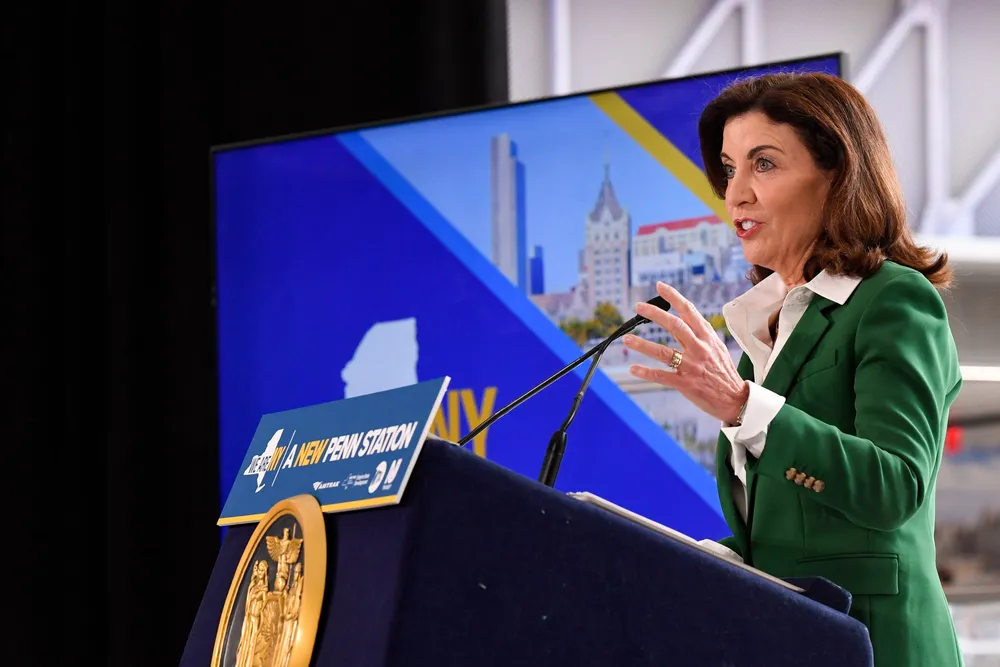New York goes for nuclear option as offshore wind dreams fade
Governor Hochul called on Trump to expedite approval of 1GW 'advanced reactor' after saying Equinor's Empire Wind took too long

New York governor Kathy Hochul yesterday kickstarted a new era in nuclear power with the announcement the state would develop a 1GW “advanced nuclear power plant” to help it meet surging demand as its offshore wind sector languishes under President Donald Trump's relentless assault.
The state is a leader in climate and clean energy, mandating 9GW of offshore wind capacity by 2035 to help it achieve a 70% clean grid by 2030 and 100% by 2040.
Onshore renewables have likewise succumbed to the same pressures.
“Harnessing the power of the atom is the best way to generate steady, zero emission electricity and help this transition which we are into,” Hochul said at a press event at a hydroelectric power station at Niagara Falls.
That’s why “I'm directing the New York State Power Authority (NYPA) to develop and construct a brand new advanced nuclear plant in Upstate New York,” Hochul said.
New York has three operating nuclear power plants that generate some 20% of its total power demand. Hydroelectricity generates over 21%, while wind is at only 4.6%, according to data from grid operator New York Independent Systems Operator (NYISO). Natural gas provides some 49% of total power generation for the Empire State.
Empire in crosshairs
Empire is one of three offshore wind projects remaining in development for the erstwhile sector leader, along with Orsted’s operating 132MW South Fork and its 920MW Sunrise slated to begin construction this year.
Trump’s memorandum freezing permitting and leasing and putting projects under review threatened to undermine this remaining capacity, however, with Empire first in the crosshairs as Interior secretary Doug Burgum issued a stop-work order in April.
The month-long standoff cost the developer some $50m per week, with Equinor threatening to quit the project altogether as Hochul said she worked on Trump to lift the order, which he eventually did on 19 April.
“We got that done as well, and now that's back on track. I'm so excited about that, but it shouldn't be this hard,” Hochul said.
She said she was again "committed to working with the White House to accelerate this new project," adding that nuclear "just takes too long, and the barriers are in Washington."
"A decade of regulatory bureaucracy and red tape that must be gotten through, is a reason why it fails, and people don't even try," she added.
Trump has issued orders aimed at expediting permitting of nuclear power plants.
Nuclear NY
The Downstate region, including New York City and Long Island, currently depends on natural gas fired generation for some 90% of its power needs despite abundant renewables upstate.
Transmission bottlenecks separating the Upstate and Downstate regions likewise throttle the distribution of cleaner energy to New York City.
Hochul stressed that her administration continues to push deployment of onshore clean power generation, but “no matter how hard we fight for renewables, solar works when the sun is shining, wind turbines spin when the air is moving.
“We need electricity that's reliable all day long, regardless of the weather, outdoors,” she said.
The state Climate Action Council sees New York needing 20GW of “dispatchable clean power to complement the wind and solar resources on the system by 2050,” according to the New York State Energy Research and Development Authority (Nyserda).
Nyserda is the state agency charged with overseeing its energy transition.
NYISO's forecasts are even larger, reaching 25GW by 2040 and up to 40GW by 2050.
The governor didn’t define “advanced nuclear”, but Nyserda’s request for information referenced the federal government’s description that highlighted safety, efficiency, and cost advantage over conventional reactors currently in operation.
It could include advanced boiling water or small modular reactors or other technologies.
(Copyright)